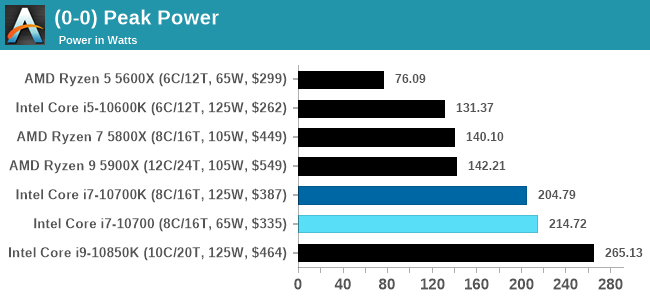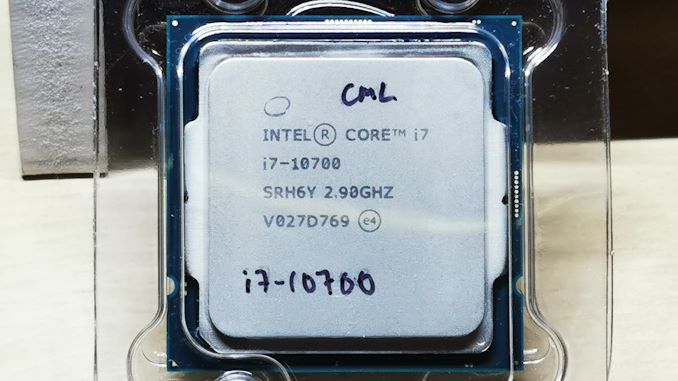Intel Core i7-10700 vs Core i7-10700K Review: Is 65W Comet Lake an Option?
by Dr. Ian Cutress on January 21, 2021 10:30 AM EST- Posted in
- CPUs
- Intel
- Core i7
- Z490
- 10th Gen Core
- Comet Lake
- i7-10700K
- i7-10700
Conclusion: TDP is Not Fit For Purpose
In years gone by, processors were sold with a single frequency and power rating. It was very quickly realized that if a processor could effectively go to sleep, using either lower voltage or lower frequency (or both) then a lot of idle power could be saved. Going the other way, processor designers realized that for temporary short bursts, a core could run at a higher frequency before it reached a thermal limit. Also, using a multi-core processor meant that either the power budget could be shared across all the cores, or it could be focused in one.
Both AMD and Intel have noticed this over time, and both companies have different attitudes on how they report numbers relating to ‘base frequency’ and related power as well as the bursty ‘turbo frequency’ and related power. Out of those four metrics, the only one Intel doesn’t provide is turbo power, because from their perspective it is system dependent.

Intel lets motherboard manufacturers determine how long a system can turbo for, and what that budget is. Intel encourages motherboard manufacturers to over-engineer the motherboards, not only for overclocking, but for non-overclockable CPUs to get the best performance for longer. This really messes up what the ‘default out-of-the-box performance’ should be if different motherboards give different values. The trend lately is that enthusiast motherboards enable an unlimited turbo budget, and the user building their system just has to deal with it.
This means that users who buy the Core i7-10700 in this review, despite the 65 W rating on the box, will have to cater for a system that will not only peak around 215 W, but sustain that 215 W during any extended high-performance load, such as rendering or compute. We really wished Intel put this 215 W value on the box to help end-users determine their cooling, as without sufficient guidance, users could be hitting thermal limits without even knowing why. At this point, 'Intel Recommended Values' for turbo time and budget mean nothing outside of Intel's own OEM partners building commercial systems.
Core i7-10700 vs Core i7-10700K Performance
In the review we highlighted that these two processors have a peak turbo frequency difference of 300 MHz and an all-core turbo frequency difference of 100 MHz. The fact that one is rated at 65 W and the other is rated at 125 W is inconsequential here, given that most end-user motherboards will simply enable turbo all the time. This means the performance in most of our tests between the two is practically identical, and consummate to a 100-300 MHz frequency difference.
In practically all of our tests, the Core i7-10700K is ahead by a super slim margin. At $387 for the 10700K compared to $335 for the 10700, the performance difference is not enough to warrant the $52 price difference between the two. Performance per dollar sides mostly with the Core i7-10700, although users getting the i7-10700K will likely look towards overclocking their processor to get the most out of it – that ultimately is what to pay for.
The other comparison point is with the Ryzen 5 5600X, which has two fewer cores but costs $299. In practically every test, the increased IPC of the Ryzen over Intel means that it sits identical with the Core i7 processors, AMD is cheaper on list price, and at a much lower power (AMD will peak around 76 W, compared to 215 W). AM4 motherboards are also abundant, while corresponding Intel motherboards are still expensive. The problem here however is that AMD is having such high demand for its product lines right now that finding one in stock might be difficult, and it probably won’t be at its recommended price.
Users in this price bracket have a tough choice – the more efficient AMD processor that might be in stock, compared to the Intel processor that will be in stock but more cooling will likely be required.











210 Comments
View All Comments
magreen - Friday, January 22, 2021 - link
Man Spunji, you are diligent. I was just going to ignore the obvious trollSpunjji - Monday, January 25, 2021 - link
It's a sensible policy - I just like debunking FUD 👍bji - Thursday, January 21, 2021 - link
Ryzen 5 5600x at $299 is a lie right now than and has been for months. It's slowly coming down to $399 with general availability. It will be months before it's actually available at $299.Please no one respond with stories of one-off deals that they happened to get from some rare and hard to find vendor, where the deal was only available for 10 minutes anyway.
The simple fact is that no Ryzen 3 processors have had general availability at anywhere near MSRP for months.
Golgatha777 - Thursday, January 21, 2021 - link
I've personally purchased 2 5600X and 1 5800X for MSRP at Micro Center?bji - Thursday, January 21, 2021 - link
Micro Center is not "general availability" given that it's only accessible to a few million people who happen to be within driving distance of one of their stores so, you fail.silverblue - Thursday, January 21, 2021 - link
Well... one stockist (OCUK) in the UK has had the 5600X at £279 for at least the past 24 hours, whereas the average on Google seems to be about £310 to £320. Your mileage may obviously vary, I suppose.bji - Thursday, January 21, 2021 - link
The US MSRP is $299 which is 218 British Pounds. So the numbers you quote indicate a significant reseller mark-up which makes my point. So thanks for agreeing with me.I wouldn't mind paying AMD a fair price ($399 apparently) for a 5600X, but I will NOT give $100 or more to scalpers. AMD will use my money to make me more of what I want (faster chips). Scalpers will use my money to just scalp me harder in the future. I will never buy a scalped product.
And so I continue to wait and wait to build a 5600X/RTX3080 gaming PC ... been waiting for months now ...
Calin - Friday, January 22, 2021 - link
I think the UK price indicate about 20% of Value Added Tax - which is paid directly at the moment of sale. If I remember correctly, US prices do not contain "State Tax" and the like.silverblue - Sunday, January 24, 2021 - link
Exactly. Aside of any delivery costs from retailer to customer, we pay what's written on the price tag. That $299 isn't looking so cheap now. Funnily, the current conversion from dollars to pounds means a near 1:1 for comparison.jimbo2779 - Friday, January 22, 2021 - link
Everything is more expensive in the UK. Our MSRP is different to yours because of import duties. MSRP is still MSRP just that our MSRP is different from your MSRP.We would not be expecting to be paying US pricing just as we wouldn't expect to pay the going rate in Australia, that is the case for every saleable item.